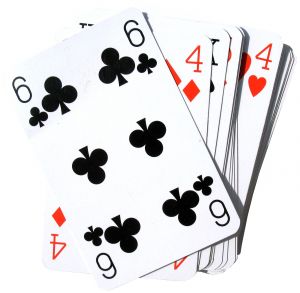 Time and money, two things of which we are forever short in education. While I can’t help you find more time, this is about inexpensive, almost free, math games. I love when I find every day, simple objects that can be used multiple ways. In my classroom, it is a simple deck of cards. You can find them at dollar stores in fun shapes and designs. You can request them from families as they usually have a deck they will donate. If you do not have cards, write 0-9 on index cards and create four sets for each “deck.” Simple, easy, fun!
Time and money, two things of which we are forever short in education. While I can’t help you find more time, this is about inexpensive, almost free, math games. I love when I find every day, simple objects that can be used multiple ways. In my classroom, it is a simple deck of cards. You can find them at dollar stores in fun shapes and designs. You can request them from families as they usually have a deck they will donate. If you do not have cards, write 0-9 on index cards and create four sets for each “deck.” Simple, easy, fun!
Here are a few ways you can use a deck of cards to practice math skills in your elementary classroom. We play the games together and then the students play them in pairs and then in centers. Anything you need to practice with numbers can be made into a game with a deck of cards.
Fraction Flash:
Materials: deck of cards, wipe board, dry erase marker, eraser
In this game, students will practice comparing fractions. Use a regular deck of cards but remove the jokers. A=1, face cards=10. Draw a horizontal line on a wipe board (use paper if you want a hard copy). Each player flips 2 cards over and places them on the wipe board, one card above the line (numerator) and one card below the line (denominator). Write the fraction. Compare your fractions. The person with the largest fraction gets to keep both cards. Use fraction circles, fraction blocks, or draw a picture to compare fractions if needed. Here is a printable fraction line if students need a visual. You can create a fraction worksheet here.
Challenge: Find common denominators among both fractions. Multiply the fraction by a number so both denominators are the same. ¼ and ½ can both have 2 as a denominator. ¼ stays ¼ and ½ is multiplied by 2 to become 2/4.
Big, Big Numbers:
Materials: deck of cards, wipe board, dry erase marker, eraser
In this game students will practice adding, subtracting, and multiplying three digit numbers. . Use a regular deck of cards, but remove the tens and face cards. A=1, joker-0. Each player flips over three cards and creates a number from those cards. Use your number and your partners’ number to add, subtract, and multiply. This can be done on a wipe board (paper if you want a hard copy). After you have computed all three answers, compare your numbers. If you both agree to the answers, start a new round. If your answers do not match, work with your partner to find the error. Here is a playing card shuffler available online. We use the big box method or lattice method for the multiplication.
Challenge: Use more cards and create bigger numbers. The number of cards does not always have to match. Write your answer in written form. Or, add a card to represent a decimal. Compute numbers using decimals. Write your answer in written form.
Do You See That Number?
Materials: deck of cards, wipe board, dry erase marker, eraser
In this game students will practice representing numbers and placing them on a number line. Use a regular deck of cards but remove the tens and face cards. A=1, joker-0. Each player turns over a card. Draw a section of a number line to represent that number and then show two other ways the number can be represented. Compare your number to your partner. The player with the highest number gets to keep all of the cards. In the second round, players turn over two cards. In the third round, players turn over three cards. Play continues (adding a card each round) until the deck is gone. Below are the possible representations for each number. You may not use the same form two rounds in a row. NAACE Primary has a nice random number generator where you can control the range.
Ways to have students represent numbers:
- Picture/Array
- Expanded notation
- Written form
- Standard form
- Place value
- Equations
Challenge: add or multiply your number with your partners after comparing the numbers.
Stack It Up:
Materials: deck of cards, wipe board, marker, eraser, small cubes, coordinate grid sheet
In this game, students will practice finding locations on a coordinate grid. Remove all tens and face cards. A=1 and joker=0. On your turn, flip over two cards. Lay them beside each other and do not change the order. Write the coordinate pair on a wipe board (use paper if you want a hard copy). Locate that spot on your grid. Mark this spot with a base ten 1’s block (or other small block) at the grid point. Your partner should check your play. Switch roles so the other player draws two cards and marks their spot. Play continues until all of the cards are used. In a subsequent turn, if the same point is marked the player stacks a block on top. The player with the highest tower wins. Here are some printable grids that are easy to use. You may want a four quadrant grid and cards with negative numbers for advanced mathematicians.
Challenge: Use a four quadrant grid and a negative number sign. Place numbers in all four quadrants.
Middle Ground:
Materials: deck of cards, wipe board, dry erase marker, eraser
In this game, students will practice calculating mean, median, mode, and range in a set of number. Remove all face cards. A=1, jokers=0. Turn over six cards and create a line plot by arranging the cards in numerical order. If you have any duplicate numbers, stack them on top of each other so you can see both cards. Look at your set of numbers. Calculate the mean average, median, and range. Do you have a mode?
Challenge: Use 10 cards in your data set and create a frequency table of your data.
Divisibility War:
Materials: deck of cards, wipe board, marker, eraser
In this game, students will practice determining divisibility rules of numbers. Remove all tens. A=1 and joker and face cards=0. Flip over four cards. Lay them beside each other and do not change the order. Write the number that is created on a T chart. The left side is the “number” and the right side is “divisible by”. Decide which numbers your number is divisible by. In the first round play divisibility by 2, 5, 10. Your partner should turn over four cards, create a number, and fill in their chart. Compare numbers. The player who has a number that is divisible by the most numbers wins all cards. If you tie, declare war. Play another set of cards and the winner takes all.
In the second round play divisibility by 2, 3, 6, 5, 9, 10. Here is a chart of divisibility rules.
Challenge: Play divisibility by 4, 6, 8. Use long division to check each of your numbers.
It always makes me smile when I can take a simple idea, turn it into a game, and my students get repeated practice at skills. It almost feels like cheating. Using a simple deck of cards is a fun way to get students to practice important math skills without realizing they are working. If you want to take a grade or see their work, have them use paper and pencil in place of the wipe board. Have fun learning!





Leave a comment